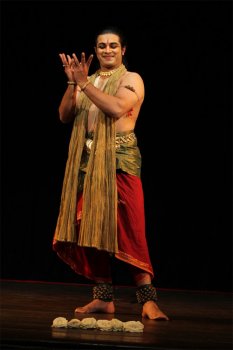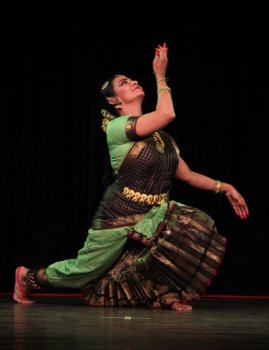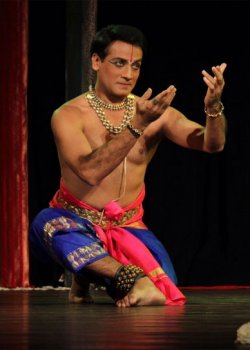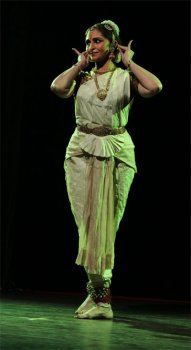
|   |

|   |
An evening of padams and javalis - Veena Murthy Vijay e-mail: veenamurthyvijay@gmail.com Photos: Anthony George December 20, 2013 Padams lend aesthetic beauty to dance whether Bharatanatyam or Kuchipudi unfolding from within the nuances of emotions, transforming the art form into a visual feast. Some of the exponents from traditional families of dancers and musicians were renowned for their presentations of these bhava filled musical compositions. The most outstanding among these artistes belonged to the veena Dhanam lineage, known to cherish rare padams and javalis as part of family heritage. It is significant that three of the grandchildren from the Dhanam family - T. Balasaraswati, Bharatanatyam legend, renowned vocalist T. Brinda and reputed flautist T. Viswanathan, were conferred the Sangita Kalanidhi by the Music Academy. The late Brinda, granddaughter of Veena Dhanam, was an outstanding musician. Kshetrayya (1600-1680), a famous composer and poet of 17th century wrote many padams in Telugu with sringara rasa as main theme expressing his intense devotion to the Lord Muvva Gopala of his native village Muvva (which means dancing bell) in Andhra Pradesh. This is known as Madhura Bhakti where a devotee identifies himself/herself as the beloved partner of the Lord and the padams are the outpourings of intense love with Lord Krishna. Kshetrayya's padams have a great impact on the dance forms of South India. In the past, Devadasis (dancers in the service of God) used to sing and perform these songs in temples but nowadays padams have become an integral part of classical dance performances on stage especially to show the artist's talent in abhinaya. Padams are intricately crafted lyrical songs. The musical structure carries a pallavi, an anupallavi and charanams. There is an intensity of outpouring of emotions in padams. Padams are usually slow moving songs, which have a depthof musical intricacies. They bring out their respective raagabhava to the utmost extent. A padam may have as its protagonist a nayaka, a nayika or a sakhi, who bring out the appropriate emotions. Javalis are livelier than padams, usually sung in madhyama kaalam. Javalis may not have an anupallavi, but have a pallavi and charanams. They may not be as serious in nature as padams. Javalis are usually composed in popular ragas, and their lyrical quality is apt for the general setting of a lively earth mood. Usha RK, Bangalore’s dynamic arts consultant has been doing some remarkable contribution inpromoting our traditional dance forms through her innovative and exquisite presentations. Unique packaging of the concept which highlights our rich tradition, with right proportion of modernity in curating these events have drawn new audiences to her classical dance events. One of them was an exclusive evening of padams and javalis in Bangalore recently. The program was both entertaining and educative to the art lovers and dancers. The general opinionof the audience is that javalis or padams can be viewed as one of the dances in a dance repertoire but Usha RK proved this otherwise by her intelligent planning of the choice of padams and javalis to be performed by some of the bright dancers of Bangalore. The musicians were also carefully chosen to render these numbers with some excellent melodic music. This planning and execution has made such an endeavour meaningful and noteworthy. Five of our city’s talented and well known dancers portrayed these compositions effortlessly in high powered performances. Tripti Bhupen, Surya N Rao, Poornima Ashok, Sathyanarayana Raju and Soundarya Srivathsa presented this fare with great spirit and authentic abhinaya.  Tripthi Bhupen Surya Rao presented Kshetrayya padam “Ika ninnu namma rade” in raga Sowrashtra, adi tala and a javali “Manini maniye kopave” composed by Dharmapuri Subbaraya, raga Daramathi, tala adi in Kuchipudi style. The hero or nayaka tells his heroine that he cannot have faith in her as her mood swings have hurt his heart. The khanditha bhava and the love filled anger were brought out with lilting Kuchipudi movements. The javali portrayed the very angry nayaka, who comes to nayaki and tries to console her with lots of love and playfulness. He tries to convince her promising on Bhramapureesha that he is not interested in any other women except her. He professes that he is not lying and that he loves her exceptionally. All these emotions were picturised with dramatic clarity and spirit. Surya’s handsome stance and vigour added color to his performance.  Surya Rao  Poornima Ashok The next performance was by one of the senior dancers of Bangalore. Known for her expertise and abhinaya skills Poornima Ashok presented the padam “Irrakam varamal” in raga Behaag, tala rupaka, composed by Gopalakrishna Bharati. The portrayal of a sad virahotkantitha was an extremely powerful rendition with highly stylized sathvika abhinaya. The lovelorn nayika seeking compassion and love from her lord was well narrated by Poornima Ashok. In the javalithe nayika has spent a night with her lover Gopala in her house when her family was away. The next morning she wakes him up and tells him to vacate the place quickly but Gopala is in no mood to go and wants to spend some more time with her. He is not serious about the situation. She is worried that her husband and her in-laws might return any time. “Samayamu kadura Sami lechi poora” was in raga Hameerkalyani, tala adi. The mood of beautiful romance, anxiety and mischief was well executed to the soulful music by Srivathsa. Sathyanarayana Raju, one of the most renowned dancers of our country, presented the sensitive all time classic “Varugalamo ayya” in Manji raga and mishrachapu tala. Gopalakrishna Bharati's opera Nandanaar Charitram is highly acclaimed. One kirtanam is “Varugalamo ayya” - Nandanaar seeking the Lord's permission, in all earnestness and humility, to come to his divine presence. Sathya brought out the humble devotion and total surrender of emotion in both pallavi and anupallavi. The aesthetic bhava and the blissful music brought a philosophic mood in the audience. It was total spiritual experience to watch Sathya render both numbers, the other number being javali “Chalu chalu nee vyaramu” in raga Dhanyasi, adi tala, composed by Nagendra Sastry. The nayaka delineates various explanations for the words “kalaharanamu chaiyaku” and finally cajoles her not to throw tantrums wasting any time and come to him.  Sathyanarayana Raju  Soundarya Srivatsa Soundarya Srivatsa presented the famous padam “Aduvum solluval” in raga Sourashtra and adi tala composed by Vaideesvarankoil Subbarama Iyer. The nayika Devayani is irked by the fact that her husband Lord Subramanya has been giving undue importance to that lower caste woman Valli. She shares this with her friend, how the other women talks ill about her to her Lord Subramanya. The innocence, the anger and spite were expressed through well-thought abhinaya and Soundarya dealt this classic composition with wonderful expertise. The javali presented the newly wedded nayika, all happy and exuberant about her new life. Immaculately dressed up, she goes for a stroll in the moon-lit evening. She is taken aback by the open love pranks of her husband in the public place. Though the nayika secretly enjoys the pranks that her husband is trying to play upon her she is also very conscious of what people may think. “Sarasamulade enduku” in raga Kaapi, tala adi by composer Poochi Srinivasa Iyengar was a lively javali with beautiful abhinaya and intelligent gestures. Soundarya ended the evening’s program with this javali. Veena Murthy Vijay is a Kuchipudi dancer and director of Sri Raja Rajeshwari Kala Niketan in Bangalore. |